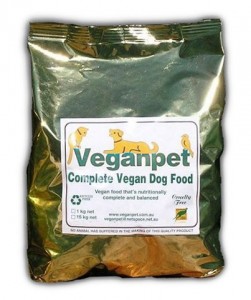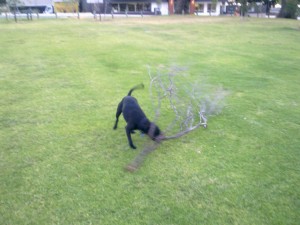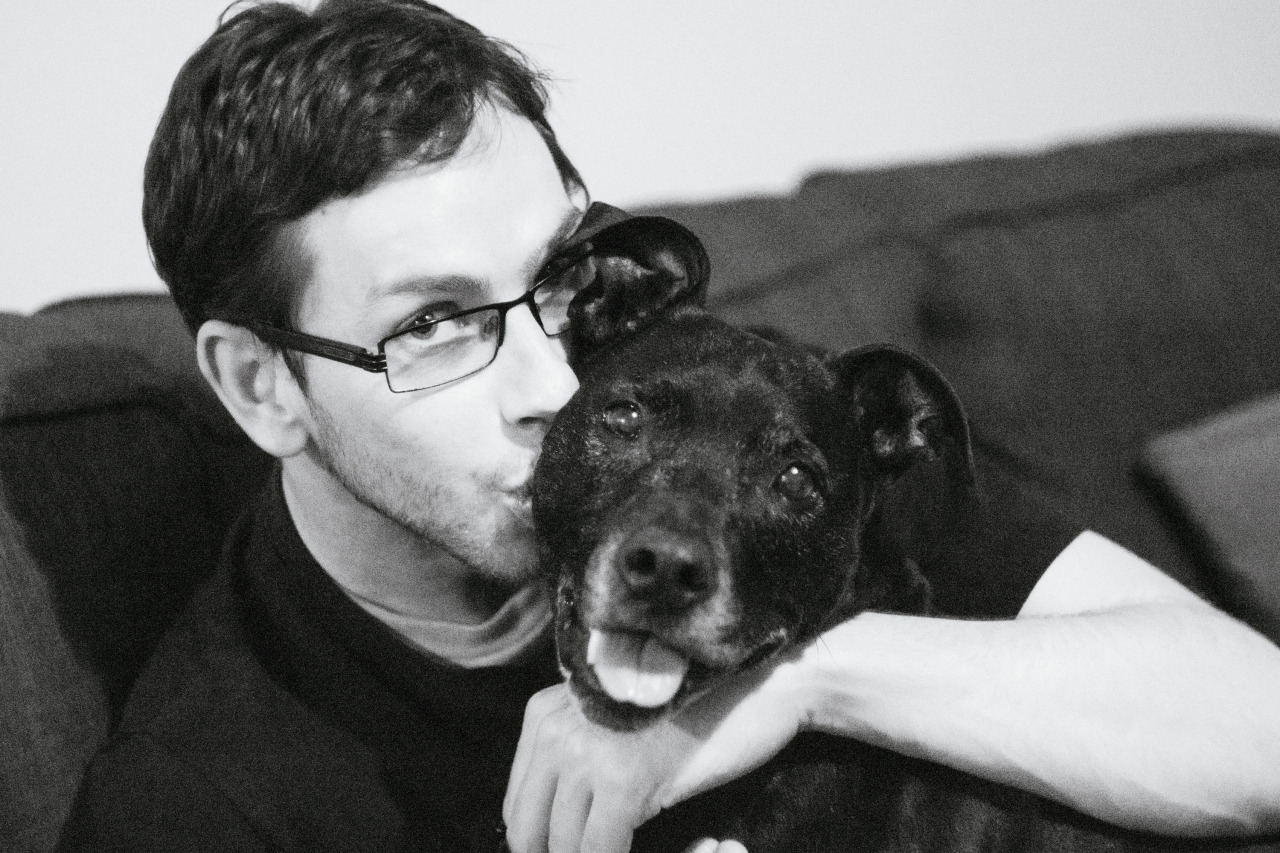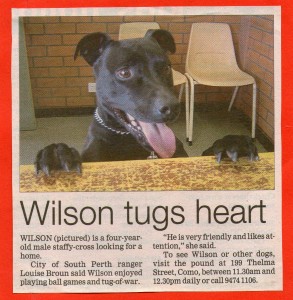How to Raise Happy, Healthy Vegan Dogs
By Nick Pendergrast
I found my dog Charlie when he ran across a busy highway in front of a bus I was on at the time. While often “stray” dogs are very scared when you approach them, after I jumped off the bus and approached Charlie, he ran up to me and hugged me and licked my face. I took him to the nearest vet to see if he had escaped from someone’s house. He wasn’t microchipped and ended up in the pound. After four weeks, no one adopted him, despite a very cute picture of him in the local paper (see below). He would have been killed at the pound, but I had told them to call me if no one adopted him. So they called me after four weeks and it was a very easy decision to take him into my home.
Before getting onto the issue of vegan diets for dogs, I thought it was worth raising the important issue of adopting companion animals. By doing this, you can save someone from being killed or living out their lives in a shelter. This is in contrast to supporting pet shops, breeders or breeding animals ourselves – all of which contribute to pet overpopulation and the many thousands of dogs and cats who are killed in shelters in Australia each year, or live out miserable lives in these shelters, with no home to go to.
Why Vegan Dogs?
I’ll get onto the practical side of vegan dogs in a moment, but before I do, I thought it would be worth briefly explaining why I feed Charlie vegan food. Our dogs can have a huge environmental impact if we feed them animal-based food. Vegan food has a much smaller environmental impact. According to a recent report from the World Preservation Foundation, a global vegan diet (of conventional crops – not even organic) would reduce dietary emissions by 87 per cent, compared to a token 8 per cent for “sustainable” meat and dairy. While this wouldn’t necessarily directly correlate with dogs, it is clear that feeding our dogs only plant-based foods avoids environmentally-destructive animal-based foods and reduces our dogs’ “carbon pawprint”.
Another reason why I feed Charlie a vegan diet is for his health. His vegan diet avoids the health problems associated with “standard” dog foods, as identified by veterinary specialist Dr Andrew Knight. After reviewing the scientific studies on vegan (and non-vegan) dogs, Dr Knight concludes that: ‘The longer a dog remains on a vegetarian or vegan diet, the greater the likelihood of overall good to excellent health’ and ‘the less likely he or she is to get cancer, infections, hypothyroidism, or suffer from obesity’. He also found that: ‘Veganism is more beneficial than vegetarianism’.
Unlike “standard” dog food, Charlie’s food is 100% human grade, a combination of Veganpet pellets and other foods. The Veganpet pellets are made up of 100% human grade ingredients, as is the food I feed him with the Veganpet pellets. As a result, Charlie is very healthy and often gets compliments on how happy and healthy he looks from vets and even people just passing him on the street. No one can believe his age and many people comment on how he looks so much younger than he is. Watch him jumping around in the video below – he still has so much energy at about 14 years old!
By far the most important reason for me though is avoiding the suffering and death many animals face to feed dogs who aren’t fed a vegan diet. I adopted Charlie to save someone’s life, however, if he was not vegan, the food I bought him would be contributing to lots of animals (who are just as sentient – capable of experiencing pleasure and pain – as he is) being killed to help this one animal. A slogan from the farm animal sanctuary Edgar’s Mission is: “If we could live happy and healthy lives without harming others… why wouldn’t we?”. For me, the same applies to my dog – it is clear that dogs can be happy and healthy without eating animal products, so why feed him animal products? Dogs, just like humans, don’t need certain foods, they just need certain nutrients, all of which can be obtained through vegan sources.
Often I’ve heard people, even vegans, say things along the lines of they’re vegan because they don’t want to impose their ethics on other animals, so they don’t want to enforce their veganism on their dog. Whatever we feed our dog, however, we’re making ethical choices on behalf of other animals. We’re making decisions on what to feed our dog but also choices for the animals who end up as our dog’s food. I think making the choice for our dog to eat vegan food is at the worst the lesser of two evils (making the decision for one animal to “miss out” on the taste of animal products so other animals are not killed for their enjoyment) but when they love their vegan food, it is not an evil at all! Charlie loves his food – clearly demonstrated by the excitement he shows as I prepare his food and the way he always licks the bowl totally clean – often waking up my partner because of how vigorously he makes sure he eats every last bit of food!
There is nothing at all natural about sharing our homes with domesticated dogs – whether we are feeding them plant-based foods or animal-based foods, their life is completely different to what their life would be like in the wild. We can’t do what is natural, so it comes down to what does the least harm – both to our dog and the other animals who can end up in their food. I believe a vegan diet clearly wins out on both counts.
Finding a Complete Food
The first step to feeding your dog a vegan diet is finding a complete (containing all of the nutrients they need) vegan dog food that contains all of the nutrients they need. Another option is adding a complete supplement to home-made food, although I find a complete food much easier. Make sure your dog regularly eats a complete food or has an adequate (complete) supplement at the very least. I have always used Veganpet because it is available near my place at Loving Hut – you can also order it online. They are sold in 1 kg but also 15kg bags. I buy the 15kg bags, which last a long time and save me some money through buying in bulk. There are many other brands of complete vegan dog food out there – check online and/or your local vegan shop, if you have one.
Once you have found a complete vegan dog food, the next step is working out some other foods to go with this. While the complete vegan dog food contains everything that your dog needs and they do not need anything else, they are likely to get sick of eating exactly the same meal every time! The first time I put the Veganpet pellets down for my dog Charlie he ate them all up without anything else added, but now I always add something different to his meals for variety.
I feed Charlie Veganpet pellets for every single meal that he eats, but I rotate between a bunch of different foods to accompany these pellets for variety. With the accompanying food, grate it or chop it up finely and mix it in with the pellets, so your dog can’t “pick out” this food and leave the pellets. The Veganpet website lists some ideas for what to feed your dog with the pellets and also some foods that are not suitable for dogs. It recommends feeding your dogs the following foods in strict moderation: onion, garlic, and chocolate/cocoa. I avoid these foods altogether in Charlie’s diet, just to be totally safe. Below I have provided some foods I add to the Veganpet pellets. Rotate between foods and see what your dog likes/doesn’t like/gets sick of/is enjoying etc.

Veganpet pellets
Feed regularly:
- Nutrisoy organic tempeh – available at Coles (chopped up finely, then fried with some oil and water).
- Tally-Ho Organic Soy burgers – available at Fresh Provisions (chopped up finely, then fried with some oil and water).
- Boiled and mashed sweet potato (for the meals he has after the meal where the sweet potato is boiled, I microwave it to warm it up a bit).
- Boiled and mashed pumpkin (for the meals he has after the meal where the pumpkin is boiled, I microwave it to warm it up a bit).
- Veganpet tinned wet food – available at Loving Hut or online.
- Cheesey sauce: In a saucepan, combine ½ cup flour and ½ cup of Lotus Savoury Yeast Flakes (Nutritional Yeast) – available at health food shops. Whisk in 2 cups of water. Heat on medium heat until bubbling and thick. Remove from heat and add ¼ cup Nuttelex vegan margarine – available at most supermarkets – and 1 teaspoon mustard. After the first time I feed him this, I microwave the sauce to warm it up for him a bit.
Feed occasionally (mock meats should only be fed occasionally because they are high in salt):
- Sanitarium Vegetarian Sausages (tinned) – available at most supermarkets. Sanitarium now label which of their products are vegan.
- Sanitarium Hot Dogs – available at most supermarkets.
- Nutrela High Protein Soya Chunks.
- Textured Vegetable Protein (TVP) – available at some health food shops.
I feed Charlie twice a day. The Veganpet website recommends feeding your dog at least twice a day, rather than in one big meal, to enhance nutrient absorption and prevent problems such as stomach cramps and choking.
When Charlie eats all of his food he gets a treat. Veganpet make a wide range of treats – available at Loving Hut or online. There are also an endless amount of vegan dog treats people can order online, as well as many recipes available online to make your own.
Charlie loves fruit, so sometimes he gets some fruit, however, the Veganpet website recommends that fruit be fed directly before or after a meal. It also recommends keeping fruit to one family of fruit at a time and removing stones and pips, which can be toxic. Occasionally Charlie even gets a “doggie” green smoothie after his meal, made by blending water, greens and a little bit of banana. Dogs like eating some greens, which they often find themselves on their walks by eating grass, although you can also feed them the cat grass from the Veganpet store. Charlie even likes munching on raw carrots, what a vegan!
Other Vegan Products Beyond Food
Charlie has had some troubles with his hips since I’ve first had him (although these problems have actually improved over time) and one vet recommended human glucosamine for him a while ago. Melrose make a vegan glucosamine (available at some health food shops), which is much better than the products most vets will suggest for these kinds of problems, which contain animals such as sharks, fish and other sea creatures. I also give him vegan canine Rose-Hip Oil – I buy this online in bulk – much cheaper than it is at pet shops! Veganpet make vegan dog toothpaste which you can order from their site and this toothpaste comes with toothbrushes. They also have vegan dog shampoo. A lot of the more natural dog shampoos available at environmental shops/websites are also vegan – just check the label for no animal products, no animal testing.
Hints for Happy, Healthy Dogs – Beyond Diet
Walks are really important. I take Charlie out twice a day for walks and runs. I encourage people to take their dog/s out for a walk or run once a day at the very least.

Charlie loves his walks – many dogs likes sticks, he prefers branches!
An obvious tip is to always make sure your dog has an adequate supply of fresh water. Beyond yearly injections and giving your dog worm tablets at the recommended intervals, make sure you pick up your dog’s excrement in the yard regularly – leaving it there for long periods of time puts your dog at greater risk of worms.
Dr Knight also recommends checking your dog’s urine acidity monthly, so you can take action to prevent urinary tract infections if required. While this is particularly important for cats, it is best to do it for dogs too, just to be sure. This is not something I’ve done with Charlie in the past, but now I am aware of it, I will definitely look into doing this. Dr Knight’s website gives tips on ensuring your dog maintains good urine acidity levels, how to check these levels and ways to restore good urine acidity levels if they are not in the correct range.
Finding a vet you trust is important too – I have a home vet for Charlie as he gets stressed out at the vet and when there is a problem that needs further action, I take him to Swan Veterinary Hospital.
If your dog has any behavioural problems, I recommend humane trainer Alana Stevenson. Her approach is not only non-violent, but also non-dominating. This means that unlike other approaches, you do not have to take steps to show you are “above” your dog. As someone who supports animal rights and opposes speciesism (discrimination based on species), I am much more comfortable with her approach. You can check out her book Training Your Dog, the Humane Way and she also does training consultations over Skype (she lives in the United States).
Summing Up
Feeding your dog a vegan diet is a little bit more effort than feeding them “standard” dog food, however, I think it is well-worth the effort – for both your dog and the animals who could end up in your dog’s food. It is really important to do everything we can to take care of our dogs, while also considering other animals too.

Charlie likes his comforts.
Further information:
For more information, listen to my interview with Dr Andrew Knight above and see the links below.
While I am not a veterinarian, this article is guided by the recommendations of experts, particularly the article ‘Vegan Dogs?’ from the Veganpet website, the article ‘Vegetarian Canine Diets‘ by veterinary specialist Dr Andrew Knight and my interview with Dr Knight (embedded above). This interview is featured on episode 26 of the podcast I co-host, Progressive Podcast Australia. You can listen to this episode for this interview and also a more in-depth look into both vegan dogs and cats, including interviews with people living with vegan dogs and cats, who give practical advice on feeding their companions vegan food and keeping them happy and healthy generally. The show notes on the website for the episode also include many links to further information, including articles and books on both vegan dogs and cats.
One more video of Charlie 🙂


